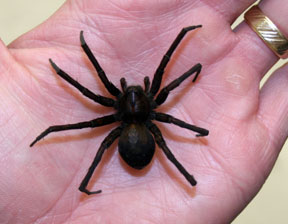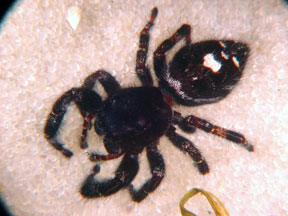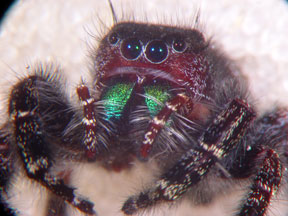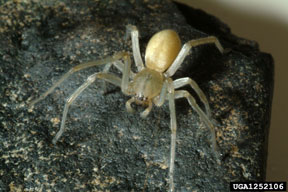Big ol’ hairy spiders
Editor’s note: This article is from the archives of the MSU Crop Advisory Team Alerts. Check the label of any pesticide referenced to ensure your use is included.
Jerry Lindquist, County Extension Director, in Osceola County sent us a very impressive wolf spider that a client had found under a tent in a backyard in Mecosta County. Wolf spiders are among our biggest and hairiest spiders. I get the sense that many people believe that the bigger and hairier a spider is the more dangerous it is likely to be. Wolf spiders and a big hairy jumping spider known as the daring jumping spider, Phidippus audax, are among the spiders that are most commonly submitted to lab. The truth is more likely to be that we have more to worry about from frail anemic looking spiders, particularly, the yellow sac spiders, Cheiracanthium inclusum and C. mildei, (Miturgidae).
Yellow sac spiders can be found walking about on foliage; under leaf litter, stones, and boards; and on buildings under the window sills and siding, in addition to the corners of walls and ceilings within homes. They probably account for more spider bites than any other spider and their bites are sometimes misdiagnosed as brown recluse bites by health care providers. C. inclusum is indigenous to much of the United States (except the northernmost states), while C. mildei, an introduced species from Europe, was found throughout much of the Northeast. Yellow sac spiders are active hunters, searching for prey rather than capturing it within a web. It is during these nighttime hunting trips that the spiders encounter humans and bite when they become trapped between a person's skin and sheets, clothing, shoes, and the like.
Yellow sac spider retreats may be found outdoors under objects or indoors in the corners of walls and ceilings. These retreats are silken tubes or sacs in which the spiders hide during the daytime. In homes with light, neutral-colored walls and ceilings, the retreats may go unnoticed, as they are small and blend in with the background coloration.



 Print
Print Email
Email







